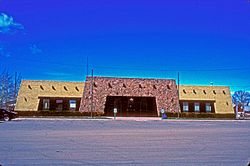2020 census
As of the 2020 census, the county had a population of 7,461. Of the residents, 26.1% were under the age of 18 and 21.6% were 65 years of age or older; the median age was 41.0 years. For every 100 females there were 99.8 males, and for every 100 females age 18 and over there were 99.8 males. 0.0% of residents lived in urban areas and 100.0% lived in rural areas. [13] [14] [15]
The racial makeup of the county was 67.6% White, 0.4% Black or African American, 2.2% American Indian and Alaska Native, 0.3% Asian, 0.0% Native Hawaiian and Pacific Islander, 14.2% from some other race, and 15.3% from two or more races. Hispanic or Latino residents of any race comprised 50.7% of the population. [15]
There were 2,896 households in the county, of which 30.3% had children under the age of 18 living with them and 24.4% had a female householder with no spouse or partner present. About 29.3% of all households were made up of individuals and 15.4% had someone living alone who was 65 years of age or older. [14]
There were 3,998 housing units, of which 27.6% were vacant. Among occupied housing units, 77.2% were owner-occupied and 22.8% were renter-occupied. The homeowner vacancy rate was 1.8% and the rental vacancy rate was 17.8%. [14]
2000 census
As of the 2000 census [16] , there were 8,400 people, 2,980 households, and 2,211 families residing in the county. The population density was 6 people per square mile (2.3 people/km2). There were 3,886 housing units at an average density of 3 units per square mile (1.2 units/km2). The racial makeup of the county was 72.76% White, 0.21% Black or African American, 1.69% Native American, 0.15% Asian, 0.07% Pacific Islander, 21.50% from other races, and 3.61% from two or more races. 58.92% of the population were Hispanic or Latino of any race.
There were 2,980 households, out of which 38.50% had children under the age of 18 living with them, 56.30% were married couples living together, 12.70% had a female householder with no husband present, and 25.80% were non-families. 23.70% of all households were made up of individuals, and 11.50% had someone living alone who was 65 years of age or older. The average household size was 2.80 and the average family size was 3.33.
In the county, the population was spread out, with 32.10% under the age of 18, 8.50% from 18 to 24, 23.60% from 25 to 44, 20.80% from 45 to 64, and 15.00% who were 65 years of age or older. The median age was 34 years. For every 100 females there were 98.50 males. For every 100 females age 18 and over, there were 98.10 males.
The median income for a household in the county was $24,744, and the median income for a family was $29,066. Males had a median income of $26,351 versus $20,200 for females. The per capita income for the county was $12,050. About 18.60% of families and 23.00% of the population were below the poverty line, including 28.20% of those under age 18 and 17.30% of those age 65 or over.



